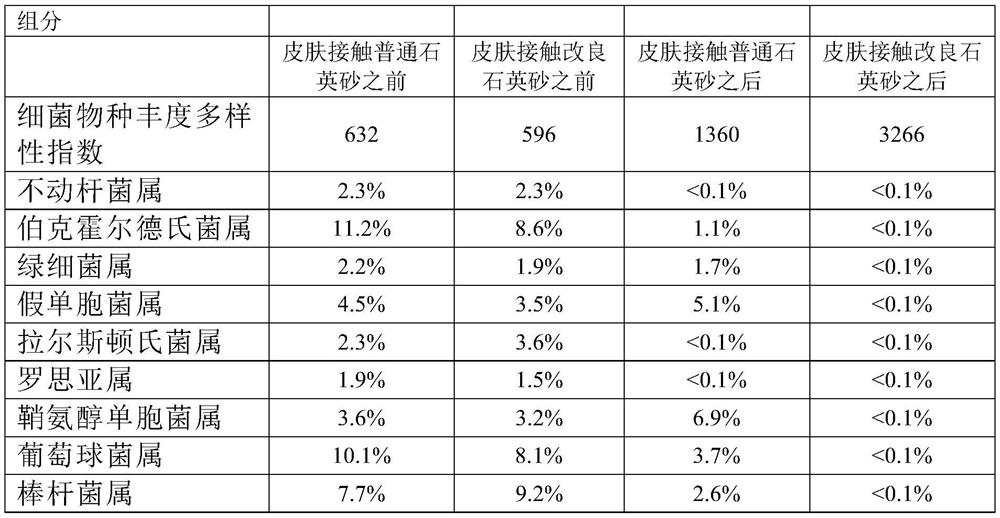Composite material for improving microbial diversity and inhibiting pathogenic bacteria and preparation method thereof
A composite material and diverse technology, applied in the fields of botanical equipment and methods, organic fertilizers, inorganic fertilizers, etc., can solve the problems of high proportion of pathogenic bacteria and poor diversity of environmental microbial communities.
- Summary
- Abstract
- Description
- Claims
- Application Information
AI Technical Summary
Problems solved by technology
Method used
Image
Examples
Embodiment 1
[0026] The used raw material component of inoculant in the embodiment is specifically:
[0027] 1. Horticultural peat soil, the peat soil is a common landscaping soil, generally through composting treatment technology (60-70 degrees Celsius in the high temperature stage, at least one hour), does not contain plant seeds.
[0028] 2. Mixed soil of pine needles and leaves on the surface layer of coniferous and broad-leaved mixed forest. This type of soil is taken from the mixed coniferous and broad-leaved forest. The main tree species include: Pinus sylvestris, larch, white birch, walnut catalpa, Mongolian oak, etc., including all litter layers and 10cm surface layer soil.
[0029] 3. Activated carbon: adopt GB / T 7701.7-1997 coal-based granular activated carbon for high-efficiency adsorption, particle pore size: 2mm.
[0030] 4. Dried moss: dry water moss for gardens.
[0031] 5, fresh pine needles: can be the needles of any kind (embodiment adopts Pinus sylvestris needles).
...
Embodiment 2-4 and comparative example 1-3
[0043] Embodiment 2-4 is the preparation of composite material, the inoculation agent of embodiment 2-4 uses the inoculation agent prepared in embodiment 1, and specific formula sees table 2 for details, and specific preparation method is: add cyclodextrin and supernatant to inoculant Calcium oxide, the humidity is adjusted to 50%, the pH is adjusted to 7 ± 0.5, and composting is carried out for 2 weeks (25 ± 5 degrees Celsius), and it is protected from rain and fully mixed.
[0044] Table 2 embodiment 2-4 and comparative example 1-3 are composite material raw material proportioning (weight part)
[0045] components Example 2 Example 3 Example 4 Comparative example 1 Comparative example 2 Comparative example 3 Inoculants 100 100 100 100 100 100 Cyclodextrin 1 0.5 1.5 - 1 - calcium peroxide 2 1.0 3.0 2 - -
Embodiment 5
[0047] The specific application effects of the composite materials obtained in the following test examples 2-4 and comparative examples 1-3 are as follows: 25 parts of composite materials are added to 75 parts of landscaping soil, and then the two are fully mixed and applied In the outdoor environment, the species abundance diversity index and the number of pathogenic bacteria were detected, and the results are shown in Table 3.
[0048] Among them, the species abundance of the microbial community was detected using the Illumina Miseq high-throughput sequencing platform to analyze the bacterial 16s rRNA gene. The total number of bacterial gene sequences was 15,000, and the human infectious pathogen index (sum) was calculated by Picrust software.
[0049] Table 3 embodiment 8-14 is application effect test result
[0050]
[0051] Note: The species abundance and diversity index refers to the original garden soil without adding composite materials.
[0052]It can be seen from...
PUM
 Login to View More
Login to View More Abstract
Description
Claims
Application Information
 Login to View More
Login to View More - R&D
- Intellectual Property
- Life Sciences
- Materials
- Tech Scout
- Unparalleled Data Quality
- Higher Quality Content
- 60% Fewer Hallucinations
Browse by: Latest US Patents, China's latest patents, Technical Efficacy Thesaurus, Application Domain, Technology Topic, Popular Technical Reports.
© 2025 PatSnap. All rights reserved.Legal|Privacy policy|Modern Slavery Act Transparency Statement|Sitemap|About US| Contact US: help@patsnap.com


